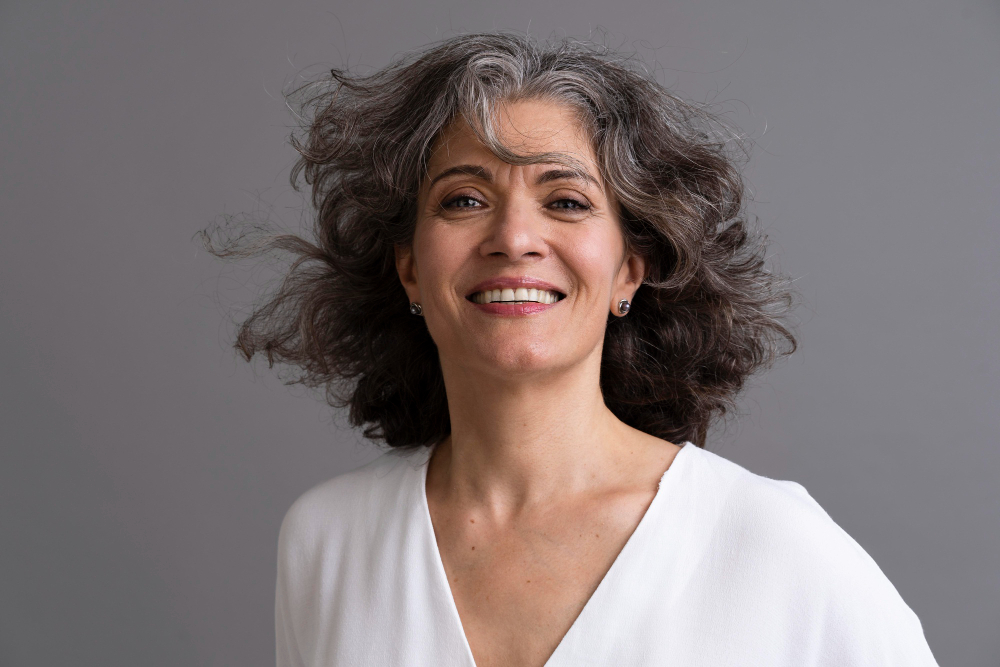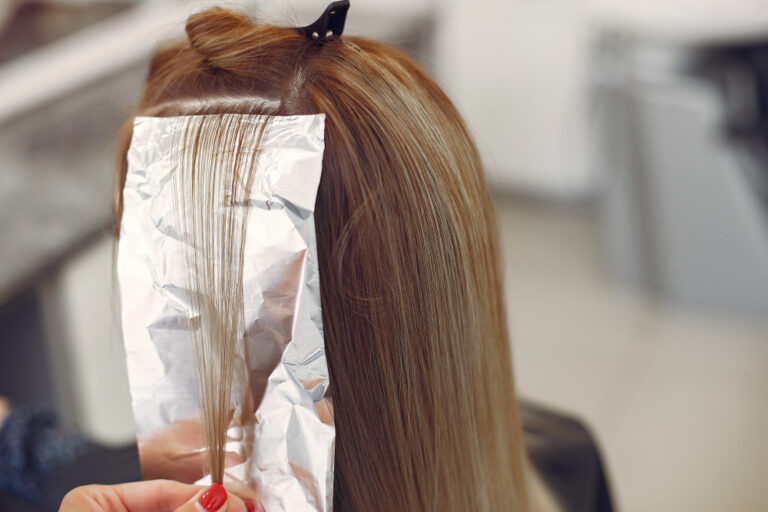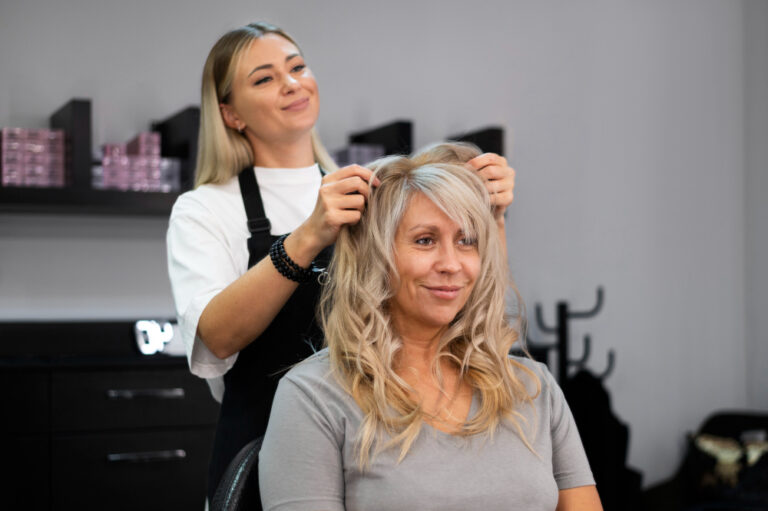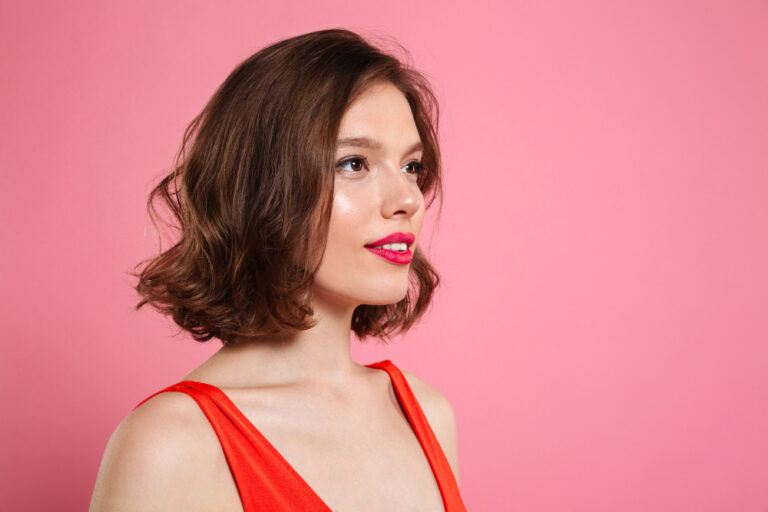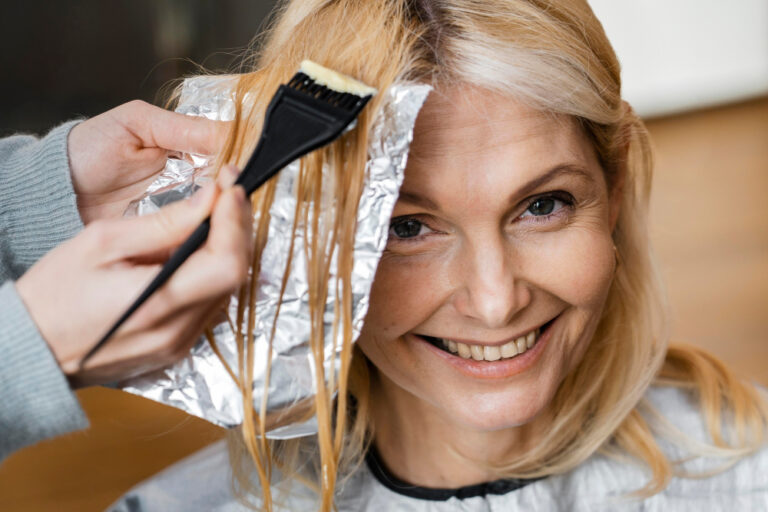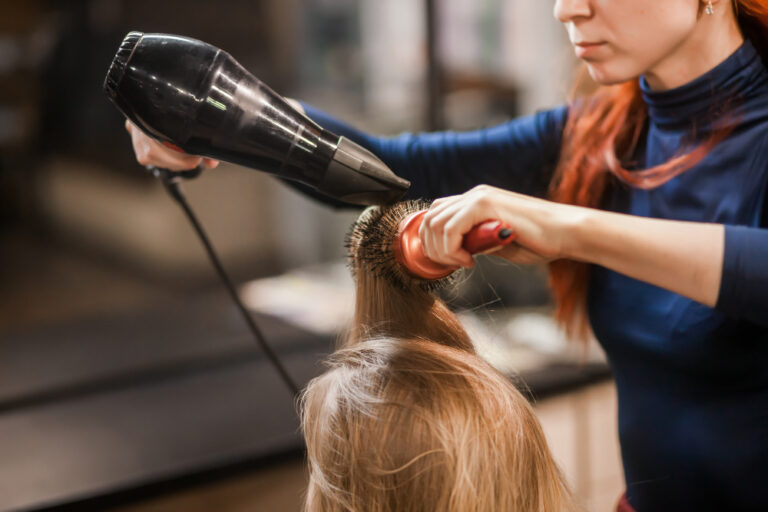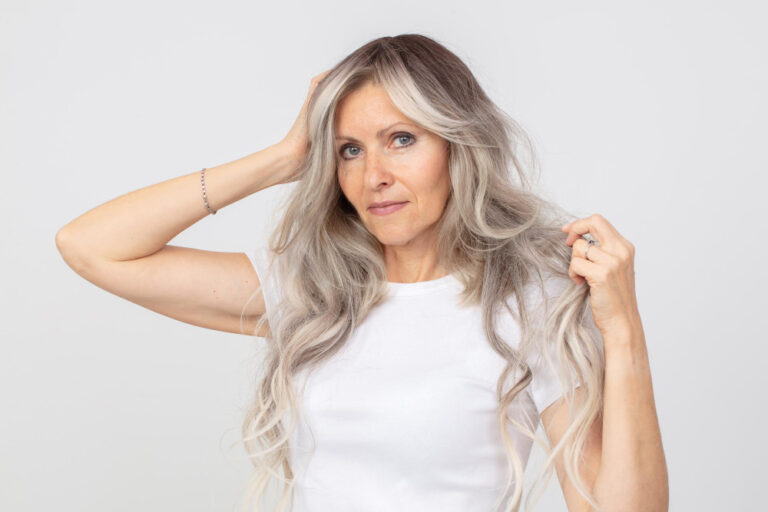When your first grays start to show, you’ve got two choices: fight them with all-over dye or work with them. Gray blending is that sweet middle ground. This is a more natural transition that lets your dark hair and silver strands play nicely together.
Instead of the harsh grow-out line you get from solid color, gray hair blending techniques have one goal… To blur the edges. When done right, your hair can look intentional, dimensional, and a lot less “I’m covering this up” and more “I meant to do this.”
In this guide, you’ll discover all about gray blending for dark hair. We’ll cover what works, what to skip, and how to choose a method that flatters both your shade and your lifestyle.
What Is Gray Blending for Dark Hair?
Gray blending for dark hair is a technique that mixes your natural grays with your existing color so they look deliberate.
The difference from traditional full-coverage dye is that gray hair blending uses highlights, lowlights, or balayage to soften the contrast between dark and silver. On the other hand, if you go with full coverage, you will have an obvious line when the roots grow out.
It’s easy to see why gray blending dark hair has exploded in popularity.
- It’s lower maintenance, so you don’t have to go back to the salon every month.
- It keeps the dimension and your color looks rich and multi-tonal.
- It allows you to embrace your grays instead of hiding them completely.
- You still got amazing results, but you’re not chained to a strict dye schedule.
Why Gray Blending Works for Dark and Dark Brown Hair
Gray regrowth stands out more easily on dark or dark brown hair. The problem is in contrast. Even a slight growth will look noticeable.
That’s why this is a great option if you have darker hair and don’t want to get full coverage every month. This technique can soften the line where your natural grays meet your dyed hair. So it’s going to result in a gradual fade from dark to light.
Popular Gray Hair Blending Techniques for Dark Hair
When it comes to blending gray hair with dark hair, it will all depend on your base shade, the amount of gray, and how soft or bold you want the transition to be. Here are the most popular techniques worth considering.
Balayage Gray Blending for Dark Hair
Balayage is perfect if you want a gradual, low-maintenance blend. Your stylist will hand-paint lighter pieces onto the surface of your hair, with the focus on the mid-lengths and ends.
This creates a seamless fade between your dark base and natural grays, without harsh root lines.
Highlights to Blend Gray on Dark Hair
Strategically placed highlights are one of the easiest ways to blend gray hair. Instead of lightening your whole head, your stylist will add fine, well-spaced highlights around the crown, hairline, and part.
This breaks up the contrast between dark regrowth and silver strands, so grays look like part of your style instead of something you’re hiding.
Lowlights Gray Blending for Dark Hair
Lowlights with darker strands woven through lighter areas can create dimension and balance.
They help prevent your color from looking washed-out, especially if your grays are concentrated in certain sections. This is a great option if you want a richer, multi-tonal finish.
Blending Gray Hair with Balayage and Lowlights Combined
A blend of balayage for soft lightness and lowlights for depth keeps the color balanced and natural.
The lighter strands help merge grays with your dark hair, while the lowlights maintain richness and prevent your overall look from going too pale.
What is the Best Hair Color to Blend with Gray Hair
Here’s what you should consider when choosing your color:
Match your undertone first:
- Cool undertones: Look for ashy browns, smoky brunettes, or cool espresso shades. These pair well with silver strands and keep the overall tone balanced.
- Warm undertones: Rich chestnut, golden browns, or warm mocha shades soften the contrast with gray while adding warmth to your complexion.
- Neutral undertones: You can pull off both cool and warm browns. Something like soft mocha, neutral chocolate, or mushroom brown can work great.
The Gray Blending Process: What to Expect
Here’s what you should know and expect before your gray blending for dark hair:
Consultation and Tone Selection
Your stylist will start by assessing your natural gray pattern, current color, and skin undertone. From there, you’ll discuss tones. This is also when you’ll choose the technique that suits you best based on your preference or the stylist’s recommendation.
If you’re looking for a hair salon in Ridgewood, NJ, visit Artists & Architects Salon. Our stylists are experts in gray blending techniques and will tailor your color to flatter your features and fit your lifestyle.
First-Session Expectations
If your base is very dark, you might not get your final look in one appointment. Blending can take more than one session, especially if you’re lifting your hair several levels to match lighter grays.
Cost Factors
Balayage gray blending tends to cost more than partial highlights because it’s more labor-intensive. Keep in mind that depending on your current hair color and how much hair you have, you may need multi-step sessions.
What Products Do You Need for Blended Gray Hair?
The right at-home care is what keeps your blended gray hair looking fresh instead of faded.
Color-Safe Shampoo & Conditioner
Start with a sulfate-free, color-safe shampoo and conditioner. They’re gentle on your tone and help your color last longer. Harsh cleansers strip pigment fast, which is the last thing you want when you’ve invested in a custom gray blending hair color.
Purple Shampoo (for Cool Tones)
If your blend leans ashy, silver, or icy, a purple shampoo is your best friend. Use it once a week to neutralize yellow tones and keep your color crisp. If you think you should use it more often, ask your stylist for a recommendation.
Gloss Refresh Between Visits
Even with the best maintenance, gray blending benefits from a gloss or toner every 6-8 weeks. This refresh boosts shine, keeps undertones balanced, and makes the whole blend look intentional again.
Key Takeaways on Gray Blending for Dark Hair
Gray blending is the ideal middle ground between full-coverage dye and going completely natural. Instead of harsh regrowth lines, you get a softer transition that works with your natural grays.
Here’s what to remember:
- It solves the high-contrast problem, which is perfect for dark or dark brown hair where gray regrowth shows fast.
- Balayage, highlights, lowlights, or a mix can all work depending on your base shade and gray pattern.
- Match your undertone (cool, warm, or neutral) for a blend that looks intentional and flattering.
- Initial sessions may take time, and upkeep includes toners or glosses every 6-8 weeks.
- Color-safe shampoo, occasional purple shampoo, and gentle maintenance go a long way.
If you’re ready to see how gray blending can work for you and you’re looking for a hair salon in Ridgewood, NJ, Artists & Architects Salon specializes in creating seamless, low-maintenance blends tailored to your style.
FAQ
How to blend gray hair with dark brown hair?
The easiest way is by adding lighter pieces. For example, techniques like balayage, highlights, or a mix of both can soften the contrast between your dark base and silver strands.
Can I do gray blending at home?
Technically, yes, but it’s not recommended. Blending requires strategic placement and tone control, and mistakes can leave you with patchy color or unwanted brassiness. A professional colorist can tailor the blend to your gray pattern and skin tone for the best results.
What’s the best color to blend gray hair with for brunettes?
Match your undertone. Cool undertones work well with ashy browns and smoky espresso. Warm undertones look great with chestnut or golden mocha. Neutral undertones can pull off both, plus mushroom brown for a trendy option.
How long does gray hair blending last?
Most blends last 3-4 months before needing a touch-up, though you may need a gloss or toner every 6-8 weeks to keep the tone fresh. Because the grow-out is softer, you can often stretch your salon visits longer than with full-coverage dye.
What’s the difference between gray hair color blending and highlights?
Highlights lighten specific strands for brightness, but they don’t always account for gray placement. Gray blending is more strategic, so regrowth looks seamless rather than stripey.

